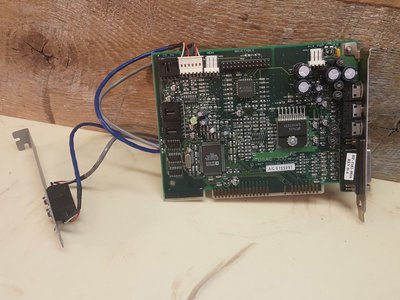The OPL3 clone on this card is actually good, providing better definition of different instruments than an OPL3 does. On the do […]
Show full quote
The OPL3 clone on this card is actually good, providing better definition of different instruments than an OPL3 does. On the downside, it doesn't work right with DN3D, and it's an obscure chipset for which drivers are hard to find.
W98SE - Windows didn't recognize the card but proceeded to load generic SBPro and OPL3 drivers: That partly worked, but wav music in Windows Media Player was mangled. Trying again using VxD drivers from the Windows 95 PnP Driver Package V1.1 (ad1812.zip) the card was better recognized: Wav music in Media Player was no longer mangled, but there was now a noticeable echo or reverb effect for which there was no control to turn it off. MIDI files played by Media Player came out with reversed channels. With either set of drivers, DOOM worked fine and SET DMXOPTION=-opl3 worked to get stereo music. The sound tests in DN3D setup sounded right but in the game itself the music was glitched.
DOS With "PNP OS Installed" set to No in BIOS setup and no drivers the card functions as an SBPro 2.0 in Mpxplay, DOOM, and DN3D. SET DMXOPTION=-opl3 works to get stereo music in DOOM.
With an MVP3 motherboard it was necessary to use the /E switch with UIDE to avoid lockups when any app tried to initialize sound.
The AD1812*SoundPort Controller is a single-chip audio sub-system for adding 16-bit stereo audio to personal computers.The ISA Plug and Play (PnP) system is compatible with applications written for Windows 95, the Microsoft Windows ® Sound System, Sound Blaster Pro ® and Ad Lib ® , and provides an MPU-compatible interface and a game port complete with timer.
ISA PnP Interface:
The chip is complete with all necessary PnP bus interface logic. This includes address decoding for on-board resources, control and signal interpretation, DMA selection and control logic, IRQ selection and control logic, all interface configuration logic. The AD1812 can support two, or three DMA channels. Included are dual DMA count registers for full-duplex operation, enabling simultaneous capture and playback on separate DMA channels. The AD1812 is configurable according to the Plug and Play ISA Specification. Table 1 lists the logical devices supported by the AD1812 that ROM coded in its PnP space. For a non-Plug and Play environment, the built in PnP services allow theAD1812 to operate under a user-defined fixed address space.
Table 1. Emulated Logical Devices
Logical Device Number Emulated Device
0 Windows Sound System
1 Sound Blaster Pro v.2.01
2 OPL3 Music Synthesizer
3 MIDI MPU-401 port
4 Game/Joystick port
Multimedia Support:
The SoundPort Controller combines an embedded 16-bit fixed-point Analog Devices signal processor and dedicated hardware to emulate all Sound Blaster version 2.01 functions. The ROM-coded music synthesis algorithms imitate industry-standard OPL3 FM synthesizer chips and can deliver 20 voice polyphony.
MPU-401:
The primary interface for communicating MIDI data to and from the host PC is the emulated MPU-401 interface, which includes a built-in FIFO for communicating to the host bus.
Game Port:
The chip includes an IBM-compatible game port interface, capable of supporting up to two joysticks. Connecting the game port to a 15-pin D-sub connector requires only a few capacitors and resistors.


